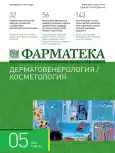A case report of partial erythroderma during Hodgkin lymphoma therapy
- Authors: Reshetnikova T.B.1, German R.V.1, Nemchaninova O.B.1, Pozdnyakova O.N.1
-
Affiliations:
- Novosibirsk State Medical University
- Issue: Vol 32, No 5 (2025)
- Pages: 143-146
- Section: Clinical case
- URL: https://journal-vniispk.ru/2073-4034/article/view/316504
- DOI: https://doi.org/10.18565/pharmateca.2025.5.143-146
- ID: 316504
Cite item
Abstract
Background: Due to its high metabolic rate, the skin is one of the main target organs for the development of chemotherapy-associated side effects. The effects range from the most common but nonspecific rashes to rare but more typical skin lesions. The physician’s task is to recognize patterns of manifestations that reflect the skin’s response to drug therapy, identify a likely trigger, and determine whether the reaction is dose-dependent toxicity [1]. Skin toxicity is a common problem in the treatment of hemoblastoses. Dermatological side effects cause physical and psychological discomfort and can also serve as a reason for abandoning therapy for the underlying hematological disease [2]. With the expansion of the range of therapeutic options for antitumor therapy, dermatological side effects are also becoming more diverse and complex for the physician [2].
Description of the clinical case: The article presents a clinical observation of a patient with developed partial erythroderma of presumably psoriatic genesis against the background of combination therapy for Hodgkin’s lymphoma.
Conclusion: The presented case allows to increase physicians’ awareness of the clinical diversity of manifestations of skin toxicity against the background of antitumor therapy for hemoblastoses.
Full Text
##article.viewOnOriginalSite##About the authors
T. B. Reshetnikova
Novosibirsk State Medical University
Email: tatyanaresh@mail.ru
ORCID iD: 0000-0002-6156-0875
Dr. Sci. (Med.), Professor, Department of Dermatovenereology and Cosmetology
Russian Federation, NovosibirskR. V. German
Novosibirsk State Medical University
Author for correspondence.
Email: rv.german@mail.ru
ORCID iD: 0009-0008-0462-8109
Postgraduate Student, Department of Dermatovenereology and Cosmetology
Russian Federation, NovosibirskO. B. Nemchaninova
Novosibirsk State Medical University
Email: obnemchaninova@mail.ru
ORCID iD: 0000-0002-5961-6980
Dr. Sci. (Med.), Professor, Head of the Department of Dermatovenereology and Cosmetology
Russian Federation, NovosibirskO. N. Pozdnyakova
Novosibirsk State Medical University
Email: pozdnyakova.o.n@mail.ru
ORCID iD: 0000-0003-1389-1001
Dr. Sci. (Med.), Professor, Department of Dermatovenereology and Cosmetology
Russian Federation, NovosibirskReferences
- Payne A.S., James W.D., Weiss R.B. Dermatologic Toxicity of Chemotherapeutic Agents. Semin Oncol. 2006;33:86–97. https://dx.doi.org/10.1053/j.seminoncol.2005.11.004
- Martin S., Frederik M., Jessica C. Hassel. Prophylaxis and management of skin toxicities. Breast care. 2019;14:72–7. https://dx.doi.org/10.1159/000497232
- Проценко Т.В., Cедаков И.Е., Логунов П.В. Токсико-аллергические дерматозы при проведении химиотерапии у онкологических больных. Новообразование. 2023;15(2):16–27. [Protsenko T.V., Sedakov I.E., Logunov P.V. Toxic-allergic dermatoses during chemotherapy in cancer patients. Novoplasma. 2023;15(2):16–27. (In Russ.)].
- Королева И.А., Болотина Л.В., Гладков О.А. и др. Практические рекомендации по лекарственному лечению дерматологических реакций у пациентов, получающих противоопухолевую лекарственную терапию. Злокачественные опухоли: практические рекомендации RUSSCO. 2021;11. [Koroleva I.A., Bolotina L.V., Gladkov O.A., et al. Practical recommendations on drug treatment of dermatologic reactions in patients receiving antitumor drug therapy. Malignant tumors: practical recommendations RUSSCO. 2021;11. (In Russ.)].
- Yoneda K., Fujii M., Imaoka A., et al. Preventive effect of edaravone ointment on cyclophosphamide-chemotherapy induced alopecia. Supp Care Cancer. 2021;29:6127–34. https://dx.doi.org/10.1007/s00520-021-06189-7
- Jutras G., Bélanger K., Letarte N., et al. Procarbazine, lomustine and vincristine toxicity in low-grade gliomas. Curr Oncol. 2018;25(1):33–9. https://dx.doi.org/10.3747/co.25.3680.
- Pease D.F., Peterson B.A., Gilles S., et al. Development of cutaneous squamous cell carcinoma after prolonged exposure to pegylated liposomal doxorubicin and hand–foot syndrome: a newly recognized toxicity. Cancer Chemother Pharmacol. 2019;84:217–21. https://dx.doi.org/10.1007/s00280-019-03849-8
- Zhu Y., Wang F., Zhao Y., et al. Pegylated liposomal doxorubicin-related palmar-plantar erythrodysesthesia: a literature review of pharmaceutical and clinical aspects. Eur J Hospital Pharm. 2021;28:124–8.
- Elomaa I., Pajunen M., Virkkunen P. Raynaud’s phenomenon progressing to gangrene after vincristine and bleomycin therapy. Acta Med Scand. 1984;216:323–6.
- Beatrice T., Davide G., Giampiero G. Bleomycin-induced Flagellate Dermatitis: a Case Report. Serbian J Dermatol Venereol. 2020;12(1):15–8. https://dx.doi.org/10.2478/sjdv-2020-0003
- Nurul H., Borrego E.A., Guerena C.D., et al. Topical administration of an apoptosis inducer mitigates Bleomycin-Induced skin fibrosis. ACS Pharmacol Translat Sci. 2023;6(5):829–41. https://dx.doi.org/10.1021/acsptsci.3c00039
- Marigny K., Aubin F., Burgot G., et al. Particular cutaneous side effects with etoposide-containing courses: is VP16 or etoposide phosphate responsible? Cancer Chemother Pharmacol. 2005;55:244–50. https://dx.doi.org/10.1007/s00280-004-0858-2
- Белышева Т.С., Шатохина Е.А., Комарова А.Д. Дерматологическая токсичность при лечении злокачественных опухолей у детей. Соврем. онкология. 2023;25(4):518–24. [Belysheva T.S., Shatokhina E.A., Komarova A.D. Dermatological toxicity in the treatment of malignant tumors in children. Sovrem Onkol. 2023;25(4):518–24 (In Russ.)]. https://dx.doi.org/10.26442/18151434.2023.4.202513
- Harris E., Tiganescu A., Tubeuf S., et al. The prediction and monitoring of toxicity associated with long-term systemic glucocorticoid therapy. Curr Rheumatol Rep. 2015;17(6):513. https://dx.doi.org/10.1007/s11926-015-0513-4.
- Koppel R.A., Boh E.E. Cutaneous reactions to chemotherapeutic agents. Am J Med Sci. 2001;321(5):327–35. https://dx.doi.org/10.1097/00000441-200105000-00005
- Marcel N.L., Juliana S. Rosa V., Fabíola Silva G.P., et al. Ex vivo model of human skin (hOSEC) for assessing the dermatokinetics of the anti-melanoma drug Dacarbazine. Eur J Pharmaceutical Sci. 2021;160:1–10. https://dx.doi.org/10.1016/j.ejps.2021.105769
- Lin N., He C., Zhang Q., et al. Efficacy and safety of standard BEACOPP regimen versus ABVD regimen for treatment of advanced Hodgkin’s lymphoma. J Cancer Res Ther. 2024;20(4):1258–64. https://dx.doi.org/10.4103/jcrt.jcrt_511_23
- Rubenstein M., Duvic M. Cutaneous manifestations of Hodgkin’s disease. Int J Dermatol. 2006;45(3):251–6. https://dx.doi.org/10.1111/j.1365-4632.2006.02675.x
- Рукавицын А.О., Ламоткин И.А., Рукавицын О.А. и др. Неспецифические поражения кожи при злокачественных лимфомах. Тихоокеанский медицинский журнал. 2020;(4):76–80. [Rukavitsyn A.O., Lamotkin I.A., Rukavitsyn O.A., et al. Nonspecific skin lesions in malignant lymphomas. Pacific Medical Journal. 2020;(4):76-80 (In Russ.)]. https://dx.doi.org/10.34215/1609-1175-2020-4-76-80
- Scott J. Hodgkin Lymphoma and Rash: What’s the Link? Verywell Health. 2024. (electronic resource). Date of access: 02.05.25.
- Pourahmad J., Kobarfard F., Amirmostofian M. Lysosomal Oxidative Stress Cytotoxicity Induced by Dacarbazine and It’s Pyridine Derivative in Hepatocytes: Dacarbazine induced lysosomal oxidative stress. Iranian J Pharmaceutical Sci. 2006;2(4):195–202. https://dx.doi.org/10.22037/ijps.v2.40321
- Schaller T., Ringen J., Fischer B., et al. Reactive oxygen species produced by myeloid cells in psoriasis as a potential biofactor contributing to the development of vascular inflammation. BioFactors. 2023;49(4):861–74. doi: 10.1002/biof.1949
- Yamamoto T., Katayama I. Vascular Changes in Bleomycin-Induced Scleroderma. Int J Rheumatol. 2011;1:270938. doi: 10.1155/2011/270938
Supplementary files












